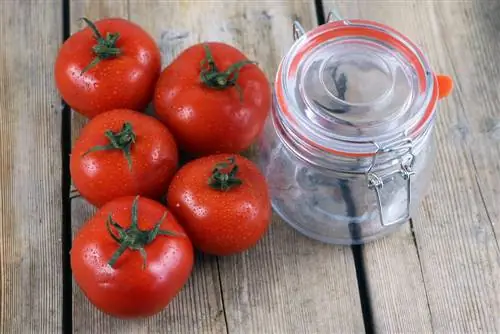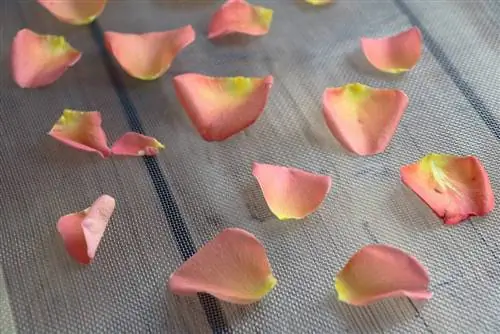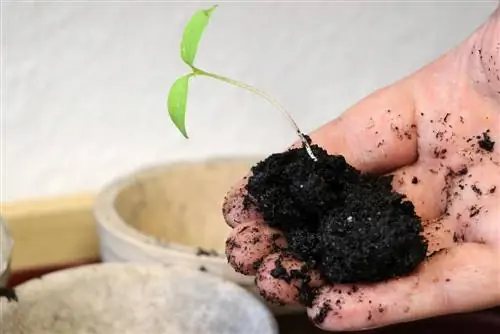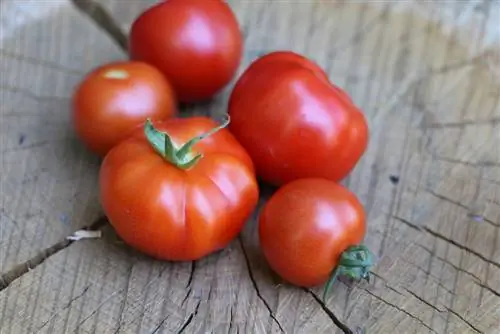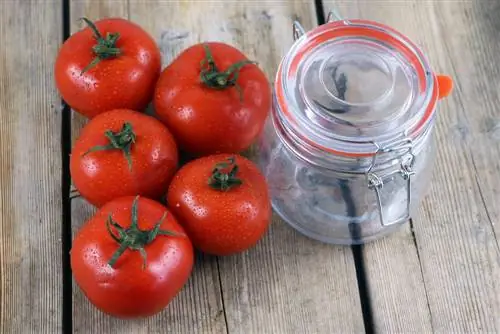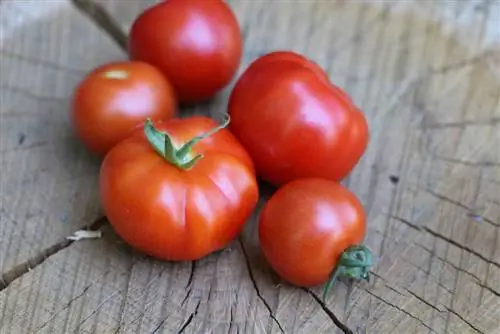- Author admin [email protected].
- Public 2023-12-17 03:39.
- Last modified 2025-01-24 12:45.
Refreshing tomato enjoyment is not limited to summer time. Preserving is the key to success in preserving the delicious fruits for many months. So that there is no boredom on the menu, we invite you on a culinary journey of discovery with delicious variations. Get inspired here with 10 tips on how to preserve tomatoes in a jar. This makes it a sophisticated tomato sauce, appetizing tomato puree and tasty tomato soup.
Consider tomato quality
One of the many advantages of preserving in a glass jar is that all types of tomatoes are possible. Nevertheless, only a hand-picked selection of fruits of perfect quality is suitable for canning. These properties guarantee a long shelf life in the jar:
- Well ripe with well-colored skin
- Undamaged skin without pressure points or brown spots
- Consistency that is firm to the touch and al dente, instead of mushy and soft overripeness
Cooking green tomatoes carries the risk that residual levels of toxic solanine will cause stomach problems. Although most of the solanine dissolves during preparation, you should first sort out green or green-spotted fruits. Since all tomato varieties are climacteric fruits, unripe specimens can ripen on the bright, warm windowsill. As long as the peel survives the process undamaged, any ripened tomato is suitable for subsequent preservation. Rotating regularly prevents pressure points. A ripe apple in the immediate vicinity accelerates the ripening process.
Blanch tomatoes & remove skin
An important indication of a tomato in top shape is the undamaged skin. This premise does not imply that the tough shell is included in the canning process. To ensure that preserved tomatoes later melt in your mouth, the fruits should be pre-treated. Blanching softens the skin enough that it can be easily removed. Here's how to proceed expertly step by step:
- Wash fruits
- Unscrew or cut off the stems
- Bring water to the boil in a pot
- Cut the bottom of a fruit in a cross shape
- Dip the cut tomato briefly into the boiling water
- Shower with cold water
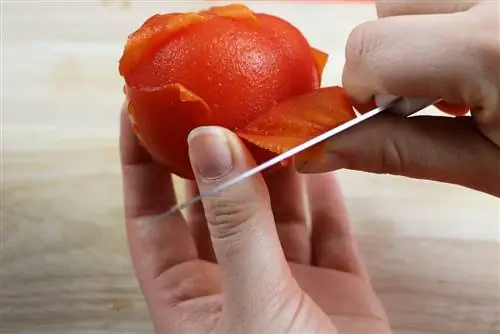
Now you can easily peel off the skin. This can be done either with a sharp kitchen knife or simply with your fingers. It is important for the process to run smoothly that a blanched tomato is only quenched for a very short time. In order to remove the peel easily, the fruit should not be allowed to cool completely.
If you don't feel disturbed by the skin during your tomato enjoyment experience, blanching and skinning can be omitted. This also applies to very small fruits, such as cocktail tomatoes. When canning voluminous beefsteak tomatoes, it is a good idea to pierce the peel in a few places with a (sterilized) sewing needle.
Meticulously sterilize mason jars
In order for a modern twist-off jar or traditional preserving jar with a rubber seal to keep your valuable tomatoes fresh for a long time, sterile cleanliness is important. Clean jars, lids and caps with hot water. Ideally, you should boil all materials in water for 10 minutes. Then use a pair of practical tongs to lift the glasses out of the boiling hot water and place them on a clean draining surface. Please use freshly washed kitchen towels to dry. You can be on the safe side when it comes to cleanliness if you then place the glasses in the preheated oven for 10 minutes at 140 degrees top and bottom heat. However, the rubber rings are not suitable for sterilization in the oven.
Canning whole fruits without air bubbles
If air bubbles get between the fruits, the shelf life of your cooked tomatoes is at risk. Even small amounts of oxygen are an excellent breeding ground for bacteria, which destroys all hopes of delicious tomato enjoyment from a jar. How to avoid the dilemma when preserving whole fruits:
- Put the blanched, peeled fruits piece by piece into the glass
- Press gently with a spoon
- Fill with boiled hot water and let cool down
- Season to taste with s alt, pepper, thyme, onions, honey, apple cider vinegar
Before sealing a jar, run a long knife blade along the edge of the inner wall. This releases the last air bubbles that have previously escaped your attention. This means that all tomato jars are perfectly prepared for preserving. To do this, place the tightly closed mason jars in a large pot three-quarters full of water. Let the water boil for 45 minutes. Refill any liquid that has evaporated so that three quarters of the glasses are continuously submerged in water. After the preserving time has elapsed, turn off the hot plate and let the jars cool in the water for another 20 minutes.
Lemon juice optimizes taste and shelf life
A little lemon juice works wonders when preserving tomatoes. Two tablespoons per glass are enough for a fruity, aromatic taste and an extra long shelf life. Add the lemon juice to the glass along with the water before adding the herbs and spices.
Without filling rim, no vacuum

The secret to a long shelf life for boiled tomatoes is a vacuum in the jar. To make this, fill a mason jar to an inch or two below the rim. In combination with the cooking process, this creates an almost airless, sterile space that slows down the aging process of the contents by up to twelve months. In addition to the filling rim, another important prerequisite for successful canning is that the lid seals airtight.
Tomato sauce ready to be seasoned
Tomato sauce is a popular alternative to whole fruit canning. Preparation and preservation go hand in hand. This has the advantage that all you have to do to consume it is open the jar and heat the tomato sauce. Let the following instructions inspire you to preserve fresh tomatoes as a tasty sauce in a jar:
Ingredients for 6 mason jars of 435 ml each
- 3 kg sun-ripened tomatoes
- 1 mixed bunch of herbs (thyme, basil, oregano, rosemary)
- 3 garlic cloves
- 2 teaspoons s alt
- 1 tablespoon sugar
- Choice of 125 ml white or red wine
- 1 pinch of pepper
- Olive oil
Preparation
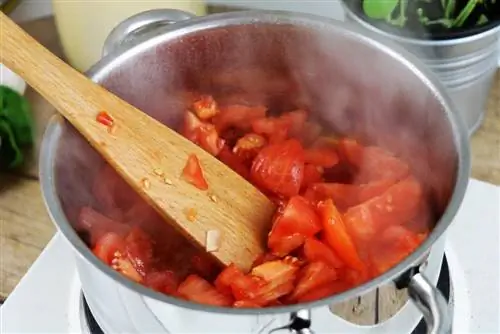
Remove green stems. Blanch, peel and dice the fruit. Finely chop the garlic cloves. Heat olive oil in a pot to sauté the garlic. Add diced tomatoes and wine to taste. Add herbs and spices, stir and bring to the boil. Simmer on a low heat with the lid closed for about 30 minutes. Remove the herb bouquet again. Process the puree with a hand blender to a fine consistency.
Waking
Pour the hot tomato sauce into sparkling clean, sterile mason jars and close them tightly. Check the rim of the glass for any drips of tomato sauce and wipe them off carefully. Please ensure there is a filling margin of one to two centimeters. While the boiling hot liquid cools down, a negative pressure forms inside the glass, which is crucial for preservation.
Canning surplus crops as tomato puree
If you have done everything right when growing tomatoes, you will have a considerable surplus harvest. Whatever goes beyond fresh consumption and daily requirements in the kitchen can be quickly and easily preserved as tomato puree. Laborious blanching is no longer necessary, as is time-consuming seasoning and seasoning. Only as part of further use does the chef take the time to add herbs and spices. This is how you can make star-quality tomato puree for the pantry:
- Wash fruits and remove stems
- Cut roughly into pieces and puree in the blender
- Pour the puree into a pot up to half the height
- Bring to the boil for 5 minutes, stirring constantly
Pour the hot tomato puree into clean screw-top or preserving jars with a small filling rim. Cover tightly and allow to cool while a preserving vacuum forms inside. The shelf life in the jar is optimized if you place the jars in a large pot and cover three quarters with water. Boil the water at 90 degrees Celsius for 20 to 25 minutes. After another 20 minutes, the glasses have cooled down and can be lifted out of the water with tongs.
Cook tomato soup ready to serve
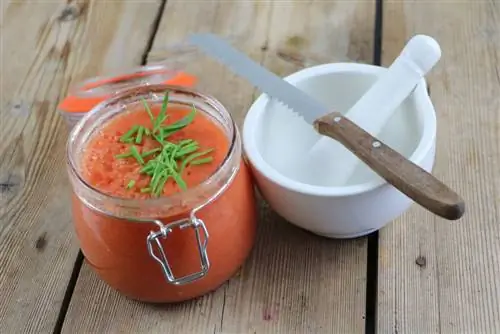
Ingenious home gardeners cook their tomato harvest into a ready-to-serve tomato soup. If guests suddenly arrive at the door or if you're feeling a little hungry in between, the fruity pleasure from the glass is just right. Using two kilograms of fresh fruit, a sprig of rosemary, five thyme stalks, two cloves of garlic and a few bay leaves, you can conjure up a tomato soup with a Mediterranean flair that can be simmered in a jar for many months.
How to do it:
- Wash the fruits, blanch them, peel them off and dice them
- Chop rosemary, thyme and garlic finely
- Put olive oil in a pot to sauté herbs and garlic
- Add diced tomatoes and sauté for 5 minutes while stirring
- Add 500 ml water and bring to the boil
- Simmer over medium heat for 10 to 15 minutes
- Remove from the fire and refine with a hand blender
- Taste with s alt, pepper and a pinch of sugar
Pour the hot tomato soup into clean, sterilized twist-off jars or classic mason jars to an inch below the rim. The hotter the liquid is when filling, the more stable the preserving negative pressure develops in the glass.
Check vacuum after cooling
The linchpin when preserving fresh fruits, fine purees or spicy tomato sauce is a stable vacuum. A visual inspection of finished jars is not sufficient to determine sufficient negative pressure. Before you store mason jars, please put them to the test. Press the lid with one finger. If the lid gives way, the contents should be consumed promptly. If the lid does not give in under pressure, the preservation has been successful.

